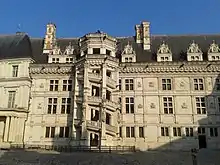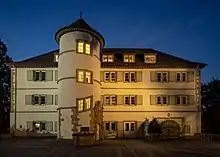Staircase tower
A staircase tower or stair tower (German: Treppenturm, also Stiegenturm or Wendelstein) is a tower-like wing of a building with a circular or polygonal plan that contains a stairwell, usually a helical staircase.
History
Only a few examples of staircase towers have survived from ancient times (e.g. on the Imperial Baths in Trier); staircases were often superfluous on the only single-storey buildings or were built into the outer walls of buildings that were often several feet thick. This tradition continued in the keeps (donjons), churches and castles of the early and high Middle Ages; and this situation only changed with the increasing construction of purpose-built and generally rather undecorated staircase towers of the High and Late Middle Ages (Romanesque and Gothic architecture styles).
Since the Renaissance period, staircase towers were markedly more decorative and representative of status. Stairs were now rarely hidden or built externally, but there were both artistically designed, curved and straight-running staircases inside the building with ornate ceilings and railings (e. g. Château de Chambord, Palazzo Barberini and Château d'Azay-le-Rideau or Château de Chenonceau). With the increasing construction of straight staircases with intermediate landings (the modern stairwells) separate staircase towers became gradually rarer.
Examples


- France
- Former abbey church of Saint-Menoux
- Château de Blois, Loire region
- Château de Chambord, Loire region
- Château de Tanlay, département of Yonne
- Germany
- Albrechtsburg, Meißen
- Lutherhaus, Wittenberg
- Latscha Building, Frankfurt-Ostend, Hesse
- Dresden Castle, Dresden
- Bertholdsburg Castle, Schleusingen, Thuringia
- Hartenfels Palace, Torgau
- Schloss Johannisburg, Aschaffenburg, Franconia
- Schloss Köthen (Anhalt)
- Weitersroda Castle, Hildburghausen, Thuringia
- Wilhelmsburg Castle, Schmalkalden, Thuringia
- Ireland
- Reeves Castle, County Kildare
See also
- Traboule, a special type of staircase tower
References
Literature
- Hans Koepf, Günther Binding: Bildwörterbuch der Architektur. Kröner, Stuttgart, 2001, ISBN 978-3-520-19404-6
External links
 The dictionary definition of staircase tower at Wiktionary
The dictionary definition of staircase tower at Wiktionary
| Wikimedia Commons has media related to Staircase towers. |
_-_%C3%89glise_Saint-Pierre-%C3%A8s-Liens-002.jpg.webp)